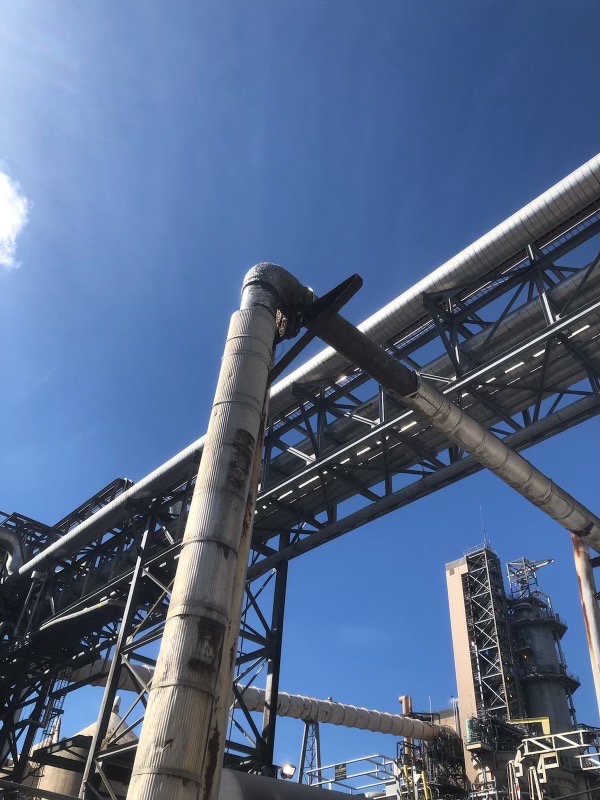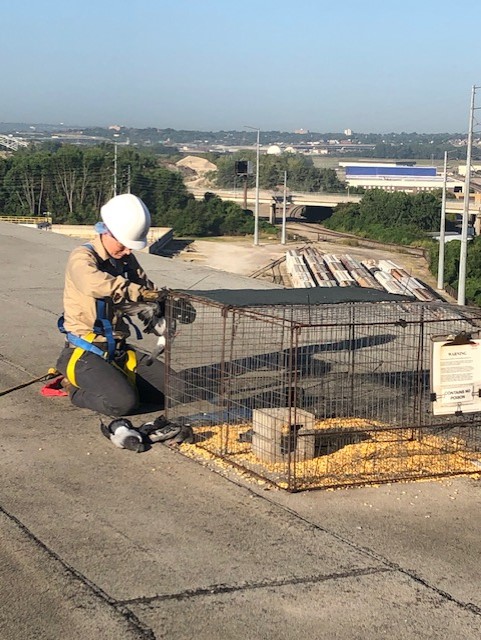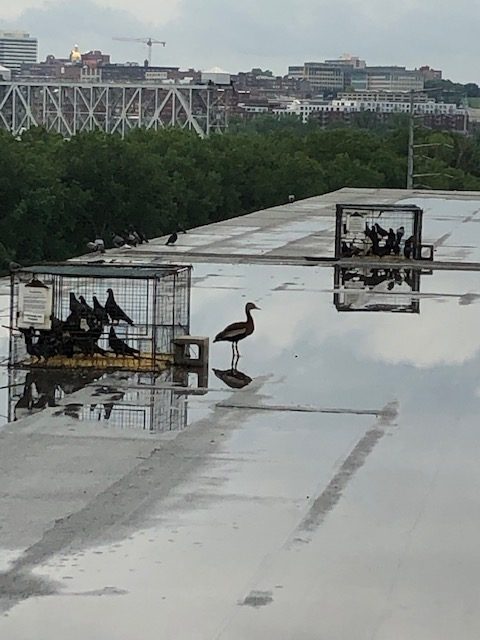At industrial facilities, you must be able to operate on schedule with equipment that is up and running and employees who are safe from harm. When wildlife invades your property, the problem must be handled swiftly.
Our professional, licensed technicians are experienced with wildlife removal and control at audited facilities. We are aware of and follow all OSHA regulations and have appropriate insurance coverage.
Honey Bee and Wasp Control
Honey bees and wasps often make their homes in industrial facilities, but their presence creates potential health and liability issues. Honey bees often make hives in the many voids in buildings’ beams and walls. They also like to create hives inside parked heavy equipment and material in laydown yards.
Common paper wasps typically distribute their nests throughout a property in high numbers, making removal difficult and time-consuming. Yellow jacket wasp nests are often concealed underground in fields or lots.
An unsuspecting worker can quickly be surrounded by angry bees or wasps as they defend their hive or nest. This is particularly dangerous when a worker is unaware that he or she is allergic to bee or wasp stings. If help is not nearby, a serious health crisis – even loss of life – is possible.
Aggressive Africanized honey bees are present in the southern states we serve, and disturbing an Africanized hive can be life-threatening even for non-allergic workers. Because of our expertise with aggressive bees, many general pest control companies call on Trutech® to handle these dangerous situations.
If not properly removed and treated, bees and wasps will continue to rebuild hives and nests on your property.
Stringing Insect Control
Because honey bees are beneficial to the environment, live honey bee removal is preferred but not always possible. When feasible, our teams will work with our network of local beekeepers to relocate the hives.
It’s important to remove the honeycomb along with the honey bee hive. If a honey bee hive is inside a wall void and the honeycomb is left behind, the honey will rot and attract pests – and bees from other colonies will likely show up to explore the vacant cavity. Also, with no bees tending the honey, it will ooze down through ceilings and walls and cause electrical and wall damage, not to mention a big mess.
Wasp nests must be treated and removed in a way that will not disturb the wasps and cause them to aggressively seek out their unwanted “attackers.” For this reason, when planning wasp treatment and nest removal, our teams consider the time of day, your employee and customer traffic, and other variables to minimize your liability during the process. We can also seal up around your buildings to keep out wasps and nuisance animals.
Wasps sometimes nest in very high places. If you have a communications tower or other type of tower, know that aerial nest removal is no problem for us – we have portable aerial solutions that reach up to 300 feet.

Pigeon Control
Pigeons are common residents of industrial facilities, which provide countless roosting and nesting areas for the birds. Many of the high ledges and nooks pigeons prefer are inaccessible to people, but – even high up – the birds create a hazard because their droppings often fall onto walkways and work surfaces below.
Pigeon feces create multiple problems on industrial sites. Human contact with pigeon droppings is a concern for your workers because the droppings carry a variety of bacteria and fungi and can harbor several serious diseases, including salmonella and histoplasmosis. In addition, droppings on walkways and hand rails are a danger because the feces are slippery and can cause falls. Finally, pigeon droppings in contact with sensitive surfaces such as equipment hoses and utility wires can cause premature and accelerated failure due to the corrosive nature of the acids in the droppings.
Trutech® offers a wide variety of pigeon control options tailored to your specific site. Large industrial facilities often require multiple types of pigeon control to protect different areas of the property.
Techniques include:
- exclusion netting
- bird wiring
- metal screens
- electrified deterrent systems
- gel repellents
- visual deterrents such as lasers, reflectors or other light-emitting devices
- sonic and subsonic repellents.
In addition to repelling or excluding the birds, we might also suggest population reduction. This can be done in a variety of ways, but trapping is usually the most cost-effective and efficient. Trutech biologists are experts at trapping pigeons, and our trapping techniques can often remove large numbers at one time. This type of service can be done on an as-needed basis or as a recurring service, similar to pest control.
To address your pigeon problem, our bird specialists will perform a property assessment and provide recommendations tailored to the particular needs of your facility.
Bat Colony Control for Industrial Facilities
Bats are considered by many to be among nature’s most beneficial creatures. But they can also cause extensive physical damage to property by defacing buildings and equipment with odorous droppings and urine, or guano, which can eat through metal, paint, fabric and other substantial materials. Bats can also be carriers of many diseases that are responsible for respiratory ailments and fungal infections, including rabies and histoplasmosis. In addition, bat guano acts as a food source for cockroaches and other insects inside walls.
It is not uncommon for bats to find their way into industrial facilities. Any crack or crevice ½” wide can be exploited. If left unchecked, a bat roost will continue to grow, leading to an increased odor and buildup of feces and urine. If a bat is seen inside a building, it is a sign that a bat colony may be living there.
All bat species are protected by state and federal regulations, and they must be mitigated in accordance with the law. In some states, a special permit or license is required, so using a professional to handle a bat problem is highly recommended. Your first step should be to call Trutech® to assess the situation.
Commercial Bat Removal
Bat removal is a delicate procedure and should only be done by a trained professional. If removal procedures are not done carefully, bats can enter a building in great numbers, causing a serious emergency and safety risk to workers.
Trutech® offers a full-service bat removal program designed to humanely evict bats. To start, our professional technicians will perform a thorough inspection of your facility, assessing where bats are causing problems, as well as any areas where they may be able to enter structures.
We remove the bats from your property by first eliminating any potential entry points by sealing or screening them off. We then remove the bats by installing a one-way “bat valve” so they are unable to return to the roost once they leave to feed.
Note that there are specific times of year when bats can’t be removed. These “blackout dates” are in place to prevent juvenile bats – flightless and dependent on their mothers for food – from being trapped inside a structure, where they will die.
Trutech technicians are experts in bat removal and exclusion, and we offer a renewable warranty on our bat removal service. We also perform any necessary bat-proofing repairs, clean-up, sanitization and insect treatments needed to mitigate the waste bats leave behind.




